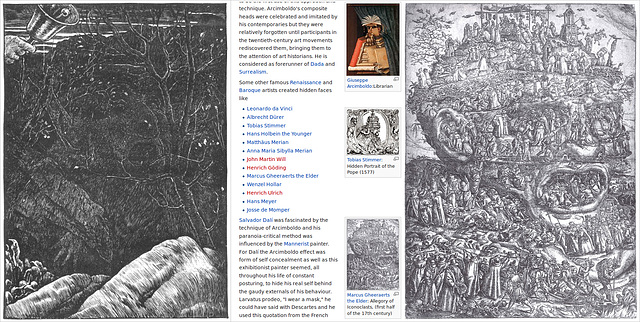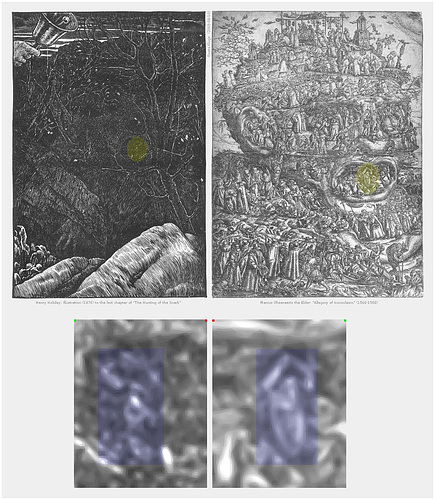The second Snark finding
John Martin' s "The Bard" prepared for analysis
John Martin - The Bard
John Martin's Bard and Henry Holiday's Snark Illus…
The Banker and The Bonnetmaker
Ear & Embryo
jub jub jub jub jub jub jub jub jub jub jub jub ..…
The Bellman and Charles Darwin
Tree of Life
h30
Bellman & Bard after retinex filtering
Snarking or Gnashing
6 Sources to the Beaver's Lesson
Ditchley Snark
Visit of Saint Anthony to Saint Paul
Grünewald and Holiday
Fun with Allusions
He stood on his head till his waistcoat turned red
Bankersnatched by the Bandersnatch
Darwin's Study and the Baker's Uncle
Easter Greeting
Carroll's Barrister's Dream
See also...
See more...Keywords
Authorizations, license
-
Visible by: Everyone -
All rights reserved
-
2 843 visits
About my Snark hunt


===== How I got into Snark hunting =====
In December 2008, I searched for “Hidden Faces” in the Wikipedia. I wanted to see whether an illustration by Henry Holiday (left) to Lewis Carroll’s The Hunting of the Snark was mentioned there. (Now it is.) But instead of that I found Gheeraert's Allegory of Iconoclasm (right, aka The Image Breakers) in the Wikipedia article on hidden faces. And then I saw a little rhombic pattern in the “mouths” of the “heads” depicted in both illustrations. The Snark hunt had begun.
left:
2009: Illustration by Henry Holiday to fit the eight in Lewis Carroll's The Hunting of the Snark
(This is the 2007 version of an image in ebooks.adelaide.edu.au/c/carroll/lewis/snark/#fit8.)
center:
2008-12-16: Detail from "Hidden Faces" in en.wikipedia.org,
en.wikipedia.org/w/index.php?title=Hidden_faces&oldid=258354510
right:
Marcus Gheeraerts the Elder, Allegory of Iconoclasm, c.1566–1568 etching 15” x 10.4”, British Museum, London.
commons.wikimedia.org/wiki/File:Gheerhaets_Allegory_iconoclasm.jpg
(In December 2008 the image was smaller: upload.wikimedia.org/wikipedia/commons/archive/f/f5/20100214083045!Gheerhaets_Allegory_iconoclasm.jpg, but even there you can see the detail which cought my attention.)

(The blur is intentional. It removes unecessary details.)
In December 2008, I searched for “Hidden Faces” in the Wikipedia. I wanted to see whether an illustration by Henry Holiday (left) to Lewis Carroll’s The Hunting of the Snark was mentioned there. (Now it is.) But instead of that I found Gheeraert's Allegory of Iconoclasm (right, aka The Image Breakers) in the Wikipedia article on hidden faces. And then I saw a little rhombic pattern in the “mouths” of the “heads” depicted in both illustrations. The Snark hunt had begun.
left:
2009: Illustration by Henry Holiday to fit the eight in Lewis Carroll's The Hunting of the Snark
(This is the 2007 version of an image in ebooks.adelaide.edu.au/c/carroll/lewis/snark/#fit8.)
center:
2008-12-16: Detail from "Hidden Faces" in en.wikipedia.org,
en.wikipedia.org/w/index.php?title=Hidden_faces&oldid=258354510
right:
Marcus Gheeraerts the Elder, Allegory of Iconoclasm, c.1566–1568 etching 15” x 10.4”, British Museum, London.
commons.wikimedia.org/wiki/File:Gheerhaets_Allegory_iconoclasm.jpg
(In December 2008 the image was smaller: upload.wikimedia.org/wikipedia/commons/archive/f/f5/20100214083045!Gheerhaets_Allegory_iconoclasm.jpg, but even there you can see the detail which cought my attention.)

(The blur is intentional. It removes unecessary details.)
- Keyboard shortcuts:
Jump to top
RSS feed- Latest comments - Subscribe to the comment feeds of this photo
- ipernity © 2007-2024
- Help & Contact
|
Club news
|
About ipernity
|
History |
ipernity Club & Prices |
Guide of good conduct
Donate | Group guidelines | Privacy policy | Terms of use | Statutes | In memoria -
Facebook
Twitter

Illustration by Henry Holiday to The Hunting of the Snark (1876) and The Image Breakers (1566-1568) by Marcus Gheeraerts the Elder.
This is the first comparison which I made between a Snark illustration by Henry Holiday and another image. A second discovery followed. That is how the Snark hunt started in December 2008. At that time my dealing with Holliday's illustration perhaps was a bit too playful and some matches marked in this comparison are questionable. But it was a good start.
Improved version:
I work as an engineer in the semiconductor industry and became increasingly interested in mental workload issues in the high tech industry as part of my involvement in labor issues. In the year 2005, I incidentally found an illustration (ebooks.adelaide.edu.au/c/carroll/lewis/snark/#fit5) by Henry Holiday to Lewis Carroll's Snark ballad which showed a workplace that had a quite high potential for ergonomic improvement.
The illustration (www.snrk.de/snarkhunt/?newpics=no#353) can be used to depict various workplace hazards. It also shows all the unpleasant distractions which you don't really need during mentally challenging work. And teaching ((x+7+10)×(1000-8)/992)-17 with x=3 to a beaver is mentally challenging. (You may want to try it for other x.)
So I started to use that illustration for my work in the works council of my company. I also entered the illustration into some Wikipedia articles. And from there it made its way to Forbes online magazine (2013):
High resolution vector graphics: www.academia.edu/attachments/36020688/download_file?s=work_strip
After some time I got interested in the whole poem. It was easy to find online:
ebooks.adelaide.edu.au/c/carroll/lewis/snark. I forked their Snark edition, added line numbers, Carroll's dedication to Gertrude Chataway and Carroll's Easter Greeting, which he tipped in at front end paper of the first Snark editions in April 1876.
My forked online edition is www.snrk.de/snarkhunt/. (eBooks Adelaide have improved their site. The images still are bad. I offered them to use my scans.) I also bought myself an old edition of The Hunting of the Snark. I read it several times, which already may be difficult for English readers, but surely is very challenging for a German.
But as in 1876 the book was sold as a childrens' book, I thought that the pictures should help to explain the text. As I always was interested in the fine (more or less) arts, I looked closer at the illustrations. So, like so many other readers before, I "discovered" the hidden face in Holiday's illustration to the last "fit" of The Hunting of the Snark.
So here we are again: The "hidden face".
In December 2008, I searched for “Hidden Faces” in the Wikipedia. I wanted to see whether an illustration by Henry Holiday (left) to Lewis Carroll’s The Hunting of the Snark was mentioned there. (Now it is.) But instead of that I found Gheeraert's Allegory of Iconoclasm (right, aka The Image Breakers) in the Wikipedia article on hidden faces. And then I saw a little rhombic pattern in the “mouths” of the “heads” depicted in both illustrations. The Snark hunt had begun.
Yes, this comment is similar to the one at the top of this page.
First: Maybe I am wrong. The allusions may be illusions.
Second: For the largest part of those 130 years there was no Internet. You had to walk to those images in order to see them. And prints were not cheap. But in 2008 I only needed a computer and access to the WWW. And I had tools to prepare images for comparison quickly.
Third: Perhaps I am not the first Snark hunter who discovered Henry Holiday's Snark allusions. Alfred Parsons may have discovered and continued Henry Holiday's game already in the year 1882:
¨¨¨¨¨¨¨¨¨¨¨¨¨¨¨¨¨ by Alfred Parsons (1882) ¨¨¨¨¨¨¨¨¨¨¨¨¨¨¨¨¨ by Henry Holiday (1876) ¨¨¨¨¨¨¨¨¨¨¨¨¨¨¨¨¨
Finally, I want to express my thanks to John Tufail and to Mahendra Singh (another Snark illustrator):
John's hint in his "Illuminated Snark" to a map which may be hidden in the front cover of the Snark guided me to the "Ditchley portrait" (Marcus Gheeraerts the Younger). I could relate it to the front cover illustration to Carroll's poem. This also gave me an idea to search for art which may have influenced the back cover illustration.
Mahendra's encouragement in early 2009 after he saw my first (and lousy) comparison got me going. As for allusions to other's work of art, the Canadian Indian German cryptomorphist at that time(but unknowingly) already worked like Henry Holiday (even though he doesn't like Holiday's illustrations too much). The difference: Holiday never talked about his allusions. Singh does so quite openly. Both artists have in common, that they not only create illustrations, they also teach how to see. Also it was Mahendra who drew my attention to the "Bone Player".
My use of informatics and mathematics has been mentioned in some comments on my Snark hunting.
Yes, I use computers and mathematical principles, but I neither invented the application of computer graphics to the analysis of drawings and paintings, nor did I invent using topology for such a comparison.
Computer graphics: I am just lucky that there is the GIMP. I just use it, the maths behind e.g. the Retinex filtering has been done by others. As for peoneering the application of computer graphics to arts, my thanks goes to Lillian Schwartz.
Mathematics: There often is a relation between Holiday's illustrations and the sources to which these illustarions are an allusion, which I call "topological match" (see a later comment). But that just is a term which I use to give this relation a name. I dont use any metrics etc. to quantify the "strength" of a match.
If you want to be on the safe side, then claim that The Hunting of the Snark is complete nonsense. That claim is cool and difficult to reject.
But the nonse may be not that complete: u1.ipernity.com/38/77/73/27197773.d636613a.xls?download=SnarkedPersonalities.xls
In the table,
Bellman, Boots, Baker, Butcher, Beaver, Banker, Barrister, Bonnetmaker, Broker, Billard marker, Hope, Care, Snark and Boojum
are associated with
Charles Darwin, Thomas Cranmer, St. Corbinian, The Bard, George Liddell, Benjamin Jowett, Henry Holiday, God (not to be depicted by the illustrator), Father Time (allegory), Religion (allegory), Liberty (allegory).
Further associations:
- 42 boxes: 42 Articles of the Anglican Church
- Baker's 7 coats: 7 sacraments
- Baker's 3 pairs of boots: Trinity
- Jubjub: a clock, a chronometer, or time in general
- Breakfast at five-o’clock tea; breakfast at location with ca. OxfordTime+8
- Bathing machines: Dr. James Gully's water cure (Darwin)
- Lace making; dissection, vivisection (used by Darwin)
- Forks: tuning forks (Darwins experiments with spiders)
CLD's contemporaries in Henry Holiday's Snark illustrations?:
- Charles Darwin and the Banker
- Charles Darwin and the Bellman
- Charles Lutwidge Dodgson (Lewis Carroll) on the rocks
- Henry Holiday and the maker of Bonnets and Hoods
- Benjamin Jowett and the Butcher
- Henry George Liddell and the Billiard-marker
There also is a docoment, which you could call a table of references and allusions.
Here I probably went a bit too far. Holiday's depiction of a weed surely looks similar to Darwin's sketch of what later has been called "Tree of Life", but as far as I know, reproductions of Darwin's sketch were published in the 19th century earliest.
Nevertheless, I do believe, that Darwin's On the origin of species by means of natural selection (1859) and especially The descent of man and selection in relation to sex (1871) had an impact on Carroll's The Hunting of the Snark (1876).
But there also is evidence for matches not being incidental:
Similarities between the shapes can be incidental. But Henry Holiday also largely maintained the relation of these five shapes to each other. I call this "topological match".
There are several examples for such a match.
I put them in a special group:
Search: "The Hunting of the Snark"